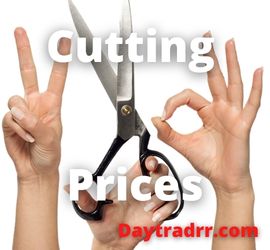Cutting Prices vs Cutting Costs
 Cutting prices is the competitive strategy of reducing prices to introduce a new product, expand market share, or drive away competitors.
Cutting prices is the competitive strategy of reducing prices to introduce a new product, expand market share, or drive away competitors.
Cutting costs refers to actions taken by a firm to cut expenses and increase profitability. Cost-cutting strategies are generally undertaken when a company is in financial difficulties or during economic downturns. They can also be implemented if a company’s management anticipates future profitability concerns. Ultimately, cost-cutting might become part of the corporate strategy.
Many manufacturers and retailers launch price-cutting programs. However, the majority fail to create a significant improvement in their competitive position. Instead, price wars are waged that harm profitability. It’s one of the most perplexing paradoxes in business. Cutting prices without a battle plan and strategy in place is usually unproductive. Yet, the most aggressive and fastest-growing competitors frequently have the lowest pricing. Many successful mature companies see their market share eroded by upstart firms offering unbeatable prices. Still, their own efforts to decrease prices deliver hardly detectable volume and market share improvements.
So, Is Cutting Prices a Good Strategy?
There are a few reasons why you might consider lowering the price of a product or service. There are usually three major reasons for this. One, the product or service isn’t selling as well as you had intended. Two, you want to expand your consumer base. A third reason is to drive away competitors. Whatever the motivation, a price reduction can entice potential buyers who were previously uninterested. However, if you intend to reduce prices, you should have a comprehensive price reduction strategy firmly in place. You shouldn’t simply drop prices and hope for the best. Without a strategy and marketing campaign in place, no one will be aware of the price adjustment. Also, you don’t want folks to make incorrect assumptions about why you are changing the pricing.
Generate Awareness
Nobody will know if you don’t publicize the fact that you’re lowering your pricing. Without telling people, it kind of negates the goal of cutting prices in the first place. For example, if you decrease the price of a product because it isn’t selling well, it still won’t sell well if no one knows about the price cut.
Inform Customers
People will make assumptions if they don’t know why you’ve reduced your costs. This can have a negative impact on your brand’s image. For example, some customers may believe that you are discontinuing the product. Maybe you are just attempting to clear your unwanted inventory. Customers are hesitant to purchase a product if a newer version is due to be released shortly.
Research Your Competition
If you want to price your goods more competitively, you need to conduct some market research. What do your competitors charge for comparable products or services? If you’re temporarily lowering your pricing, you might want to go even lower than your competitors. As a result, you may be able to steal clients who are ready to try your product or service because of the low price. But, you can’t really know until you do your homework.
Does Cutting Prices Lead to More Sales?
First, you need to understand your customer and what message a price cut will send. If you price your product or service lower than the competitors, you will transmit a different message depending on who is listening. A value shopper might quickly determine that your product or service is a steal when compared to the competition. However, your high-end customers could interpret that your product or service is of inferior quality.
Whether you’re cutting or raising pricing, you almost always have to make some form of trade-off. You must choose between increased sales volume and increased profit margins. Assuming your costs remain constant, decreasing your prices to encourage sales reduces your profit margin on each unit sold. Lower prices, on the other hand, often result in increased sales volumes, which may compensate for the lower profit margin.
Raising the price of your product or service may result in larger profit margins but reduced sales volumes. If you’re lucky, or if you brand yourself correctly, an increase in price may lead consumers to perceive your product or service as having a better value. This is the best outcome and results in an increase in both profit margins and sales.
Cutting Prices while Cutting Costs to Maintain Profitability
Shareholders typically seek high monetary returns when they invest in a company. As a result, they anticipate that management will maintain profit growth. Companies are often able to steadily grow profits while the business cycle is on the rise. However, during a downturn, profits may decline. If they remain low for an extended period of time, management may feel pressure from shareholders to slash costs in an effort to shore up the bottom line.
Cost-cutting efforts include laying off employees, reducing employee pay, closing facilities, streamlining the supply chain, downsizing to a smaller office or moving to a less expensive building or area, reducing or eliminating outside professional services, such as advertising agencies and contractors. Implementing new technology can also be viewed as a way to save money. For example, a new machine may replace a given number of employees, lowering labor expenses, with the cost of the machine offset after a certain amount of time without incurring labor expenditures.
Cost Cutting Strategy
Before cutting costs indiscriminately, it is critical to devise and implement a well-thought-out cost-reduction strategy. Some expenditures are unavoidable, so it is critical to categorize costs first.
Good costs are focused on the company’s growth and are connected with the company’s customers and how to meet their needs. Bad costs are those that are unrelated to the company’s growth goal and squander resources. When bad costs are reduced, resources that could be used more productively become available. Best costs are those linked with what distinguishes a company, how it distinguishes itself from the competition, and how it offers actual value to its customers. Once a corporation can allocate its costs into one of the above categories, it will be easier to focus on decreasing bad costs and maximizing good costs. It’s also worth noting that cost-cutting does not always imply entirely eliminating an expense. It can also relate to efficiency and optimization. Because increasing productivity lowers costs, it is critical to track productivity. There are now apps that allow businesses to track staff productivity as well as time spent on various tasks and projects. (Source: investopedia.com)
Cutting Prices – Advantages
- Jump-start sales – It can create a quick burst of sales during slow times.
- Improve cash flow – It can temporarily improve cash flow.
- An introduction offer – It’s a good way to introduce a new product faster and to a wider audience.
- Move older products – It’s a simple way to get rid of excess inventory or discontinued items.
- Push out the competition – If your business is financially secure, you can use it to drive away competitors.
Cutting Prices – Disadvantages
- Comes to be expected – Customers come to expect it, especially if it’s a straightforward price decrease with no other components.
- Reduces profit – It creates a disproportionate decrease in profits.
- Greater risk – It’s more work for the business and it takes longer to recover from mistakes, exchanges, and refunds.
- Negative long-term effects – It can lead to long-term loss and a decline in long-term sales. You start to attract the wrong kind of customer—the price shopper.
- Lowers perceived value – It can create a lower perceived value (people think your product is simply worthless)
- Can damage your brand – Customers who paid full price could resent your price cuts. Prospects perceive your product as less valuable.
- Temporary impact – It’s not a band-aid for systemic problems. For instance, it won’t fix lousy customer service.
- Can impact production costs – Costs might go up. For instance, if you increase your volume, your miscellaneous variable costs might go up, negating the purpose of the price cut.
- Starts a price war – Your competitors might respond with even more price cuts, which can lead to a price war. No one wins. (Source: smallbusinessrainmaker)
The Downside to Cost Cutting
Wages and salaries are a major expense. Therefore, many businesses turn to layoffs first as a cost-cutting tool when times are tough. However, there are other real or prospective expenses connected with terminating someone. This can include severance compensation, unemployment benefits, rehiring fees, wrongful termination claims, morale loss, and the risk of overworking existing employees.
Furthermore, if the business rebounds faster than management anticipated, the company may face a personnel shortage. It would result in a competitive disadvantage during an improving business environment. If a facility was recently shuttered as part of a cost-cutting exercise, the corporation may not have the manufacturing capacity to respond to a sudden rise in orders. All of this contributes to making certain that the company’s cost-cutting plan is sound and adaptive.
Cutting Prices – Real-life Example
Creating low-price appeal is often the goal. But, the result of one retaliatory price slashing after another is often a precipitous decline in industry profits.
- Airline price wars of 1992. When American Airlines, Northwest Airlines, and other U.S. carriers went toe-to-toe in matching and exceeding one another’s reduced fares, the result was record volumes of air travel—and record losses. Some estimates suggest that the overall losses suffered by the industry that year exceed the combined profits for the entire industry from its inception.
- Long-distance phone rates – In July 1999, Sprint announced a nighttime long-distance rate of 5 cents per minute. In August 1999, MCI matched Sprint’s off-peak rate. Later that month, AT&T acknowledged that revenue from its consumer long-distance business was falling, and the company cut its long-distance rates to 7 cents per minute all day, every day, for a monthly fee of $5.95. AT&T’s stock dropped 4.7% the day of the announcement. MCI’s stock price dropped 2.5%; Sprint fell 3.8%. (Source: hbr.org)
Up Next: What Is the Monetary Conditions Index (MCI)?
 The monetary conditions index (MCI) was created in the early 1990s to capture two significant monetary transmissions. It combines changes in the short-term interest rate and the effective exchange rate into a single variable or index to gauge the relative ease or tightness of monetary conditions. The metric assists central banks in developing monetary policy. As a result, the monetary conditions index (MCI) has become a worldwide standard.
The monetary conditions index (MCI) was created in the early 1990s to capture two significant monetary transmissions. It combines changes in the short-term interest rate and the effective exchange rate into a single variable or index to gauge the relative ease or tightness of monetary conditions. The metric assists central banks in developing monetary policy. As a result, the monetary conditions index (MCI) has become a worldwide standard.
The Bank of Canada created the monetary conditions index in the early 1990s. The purpose was to investigate the linkages between Canadian interest rates, the relative trade exchange rate of Canadian currency, and the Canadian economy as a whole. On a monthly basis, the bank releases data for both the MCI and its components.



